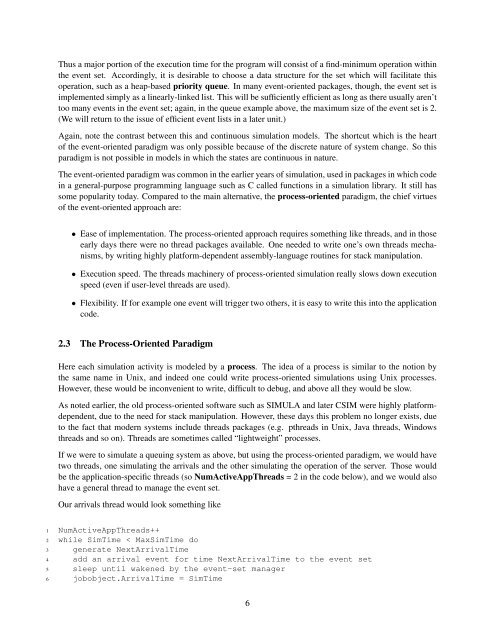Introduction to Discrete-Event Simulation and the SimPy ... - matloff
Introduction to Discrete-Event Simulation and the SimPy ... - matloff
Introduction to Discrete-Event Simulation and the SimPy ... - matloff
You also want an ePaper? Increase the reach of your titles
YUMPU automatically turns print PDFs into web optimized ePapers that Google loves.
Thus a major portion of <strong>the</strong> execution time for <strong>the</strong> program will consist of a find-minimum operation within<br />
<strong>the</strong> event set. Accordingly, it is desirable <strong>to</strong> choose a data structure for <strong>the</strong> set which will facilitate this<br />
operation, such as a heap-based priority queue. In many event-oriented packages, though, <strong>the</strong> event set is<br />
implemented simply as a linearly-linked list. This will be sufficiently efficient as long as <strong>the</strong>re usually aren’t<br />
<strong>to</strong>o many events in <strong>the</strong> event set; again, in <strong>the</strong> queue example above, <strong>the</strong> maximum size of <strong>the</strong> event set is 2.<br />
(We will return <strong>to</strong> <strong>the</strong> issue of efficient event lists in a later unit.)<br />
Again, note <strong>the</strong> contrast between this <strong>and</strong> continuous simulation models. The shortcut which is <strong>the</strong> heart<br />
of <strong>the</strong> event-oriented paradigm was only possible because of <strong>the</strong> discrete nature of system change. So this<br />
paradigm is not possible in models in which <strong>the</strong> states are continuous in nature.<br />
The event-oriented paradigm was common in <strong>the</strong> earlier years of simulation, used in packages in which code<br />
in a general-purpose programming language such as C called functions in a simulation library. It still has<br />
some popularity <strong>to</strong>day. Compared <strong>to</strong> <strong>the</strong> main alternative, <strong>the</strong> process-oriented paradigm, <strong>the</strong> chief virtues<br />
of <strong>the</strong> event-oriented approach are:<br />
• Ease of implementation. The process-oriented approach requires something like threads, <strong>and</strong> in those<br />
early days <strong>the</strong>re were no thread packages available. One needed <strong>to</strong> write one’s own threads mechanisms,<br />
by writing highly platform-dependent assembly-language routines for stack manipulation.<br />
• Execution speed. The threads machinery of process-oriented simulation really slows down execution<br />
speed (even if user-level threads are used).<br />
• Flexibility. If for example one event will trigger two o<strong>the</strong>rs, it is easy <strong>to</strong> write this in<strong>to</strong> <strong>the</strong> application<br />
code.<br />
2.3 The Process-Oriented Paradigm<br />
Here each simulation activity is modeled by a process. The idea of a process is similar <strong>to</strong> <strong>the</strong> notion by<br />
<strong>the</strong> same name in Unix, <strong>and</strong> indeed one could write process-oriented simulations using Unix processes.<br />
However, <strong>the</strong>se would be inconvenient <strong>to</strong> write, difficult <strong>to</strong> debug, <strong>and</strong> above all <strong>the</strong>y would be slow.<br />
As noted earlier, <strong>the</strong> old process-oriented software such as SIMULA <strong>and</strong> later CSIM were highly platformdependent,<br />
due <strong>to</strong> <strong>the</strong> need for stack manipulation. However, <strong>the</strong>se days this problem no longer exists, due<br />
<strong>to</strong> <strong>the</strong> fact that modern systems include threads packages (e.g. pthreads in Unix, Java threads, Windows<br />
threads <strong>and</strong> so on). Threads are sometimes called “lightweight” processes.<br />
If we were <strong>to</strong> simulate a queuing system as above, but using <strong>the</strong> process-oriented paradigm, we would have<br />
two threads, one simulating <strong>the</strong> arrivals <strong>and</strong> <strong>the</strong> o<strong>the</strong>r simulating <strong>the</strong> operation of <strong>the</strong> server. Those would<br />
be <strong>the</strong> application-specific threads (so NumActiveAppThreads = 2 in <strong>the</strong> code below), <strong>and</strong> we would also<br />
have a general thread <strong>to</strong> manage <strong>the</strong> event set.<br />
Our arrivals thread would look something like<br />
1 NumActiveAppThreads++<br />
2 while SimTime < MaxSimTime do<br />
3 generate NextArrivalTime<br />
4 add an arrival event for time NextArrivalTime <strong>to</strong> <strong>the</strong> event set<br />
5 sleep until wakened by <strong>the</strong> event-set manager<br />
6 jobobject.ArrivalTime = SimTime<br />
6





